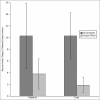Outcome of retinopathy of prematurity patients following adoption of revised indications for treatment
- PMID: 19014557
- PMCID: PMC2605435
- DOI: 10.1186/1471-2415-8-23
Outcome of retinopathy of prematurity patients following adoption of revised indications for treatment
Abstract
Background: The Early Treatment for Retinopathy of Prematurity study (ETROP), published in 2003, established new guidelines for treatment of retinopathy of prematurity (ROP) and demonstrated improved outcomes compared to previous guidelines. We examined outcomes before and after implementing the ETROP recommendations.
Methods: A retrospective chart review was performed using records of infants who had laser ablations for ROP performed from January, 2000 through December, 2005. Data collected included date of birth; birth weight; estimated gestational age (EGA); grading of ROP; date of laser ablation; and outcome of laser surgery. Univariate association with threshold or prethreshold treatment (Pre-ETROP and Post-ETROP, respectively) were assessed using t-tests or Wilcoxon tests. Additional comparison between groups was performed using Fisher's exact tests.
Results: 581 patients were examined before and 464 after December 2003. Of these, 29/581 (5% - Pre-ETROP Group) and 53/464 (11% - Post-ETROP Group) patients advanced to criteria requiring laser treatment respectively (P = 0.0001). The average estimated gestational age (EGA) at birth was 26.3 and 25.2 weeks, with an average birth weight of 888 and 707 grams for Pre and Post-ETROP Groups, respectively. Stage 5 retinal detachment (RD) developed in 10.3% of eyes in the Pre-ETROP Group and 1.9% of eyes in the Post-ETROP Group (P = 0.02).
Conclusion: After the ETROP guidelines were implemented, there was a decrease from 10.3% to 1.9% of eyes developing Stage 5 retinal detachment, despite this group having a lower average EGA and lower average birth weight. These results underscore the importance of adoption of the Revised Indications.
Figures

Similar articles
-
Outcome of eyes developing retinal detachment during the Early Treatment for Retinopathy of Prematurity Study (ETROP).Arch Ophthalmol. 2006 Jan;124(1):24-30. doi: 10.1001/archopht.124.1.24. Arch Ophthalmol. 2006. PMID: 16401781 Clinical Trial.
-
Retinopathy of prematurity in infants weighing less than 500 grams at birth enrolled in the early treatment for retinopathy of prematurity study.Ophthalmology. 2011 Jun;118(6):1145-51. doi: 10.1016/j.ophtha.2010.09.031. Epub 2011 Jan 6. Ophthalmology. 2011. PMID: 21211840 Free PMC article. Clinical Trial.
-
Revised indications for the treatment of retinopathy of prematurity: results of the early treatment for retinopathy of prematurity randomized trial.Arch Ophthalmol. 2003 Dec;121(12):1684-94. doi: 10.1001/archopht.121.12.1684. Arch Ophthalmol. 2003. PMID: 14662586 Clinical Trial.
-
[Outcomes of surgical management of retinopathy of prematurity--an overview].Klin Oczna. 2014;116(2):138-41. Klin Oczna. 2014. PMID: 25345295 Review. Polish.
-
Treatment of retinopathy of prematurity.Early Hum Dev. 2008 Feb;84(2):95-9. doi: 10.1016/j.earlhumdev.2007.11.007. Early Hum Dev. 2008. PMID: 18280405 Review.
Cited by
-
Retinopathy of prematurity occurrence and evaluation of screening policy in a large tertiary Greek cohort.Int Ophthalmol. 2020 Feb;40(2):385-391. doi: 10.1007/s10792-019-01195-5. Epub 2019 Oct 22. Int Ophthalmol. 2020. PMID: 31641909
-
17β-estradiol ameliorates oxygen-induced retinopathy in the early hyperoxic phase.Biochem Biophys Res Commun. 2015 Feb 20;457(4):700-5. doi: 10.1016/j.bbrc.2015.01.052. Epub 2015 Jan 22. Biochem Biophys Res Commun. 2015. PMID: 25619134 Free PMC article.
-
Evaluation of segmental scleral buckling surgery for stage 4A retinopathy of prematurity in China.Front Med (Lausanne). 2022 Aug 3;9:969861. doi: 10.3389/fmed.2022.969861. eCollection 2022. Front Med (Lausanne). 2022. PMID: 35991664 Free PMC article.
-
Type I retinopathy of prematurity in infants with birth weight less than 1251 g: incidence and risk factors for its development in a nursery in Kuwait.Middle East Afr J Ophthalmol. 2013 Jan-Mar;20(1):66-71. doi: 10.4103/0974-9233.106393. Middle East Afr J Ophthalmol. 2013. PMID: 23580855 Free PMC article.
-
Association of Maternal Age to Development and Progression of Retinopathy of Prematurity in Infants of Gestational Age under 33 Weeks.J Ophthalmol. 2014;2014:187929. doi: 10.1155/2014/187929. Epub 2014 Apr 30. J Ophthalmol. 2014. PMID: 24876945 Free PMC article.
References
-
- Terry TL. Extreme prematurity and fibroblastic overgrowth of persistent vascular sheath behind each crystalline lens. I. Preliminary report. Am J Ophthalmol. 1942;25:203–4. - PubMed
-
- McNamara J. Laser photocoagulation for stage 3+ retinopathy of prematurity. Ophthalmology. 1991;98:576–580. - PubMed
-
- International Committee for the Classification of the Late Stages of Retinopathy of Prematurity An international classification of retinopathy of prematurity. II. The classification of retinal detachment. Arch Ophthalmol. 1987;105:906–12. - PubMed
-
- Committee for the Classification of Retinopathy of Prematurity An international classification of retinopathy of prematurity. Arch Ophthalmol. 1984;106:471–9.
Publication types
MeSH terms
LinkOut - more resources
Full Text Sources
Miscellaneous

